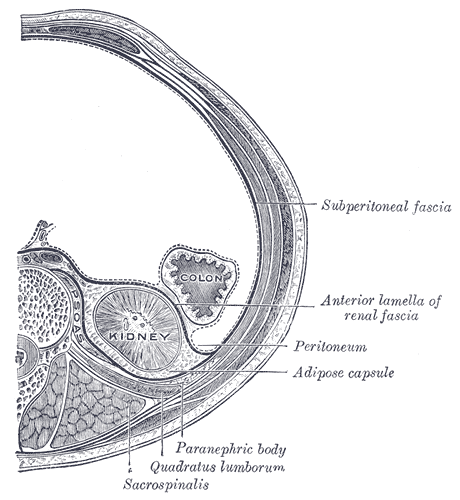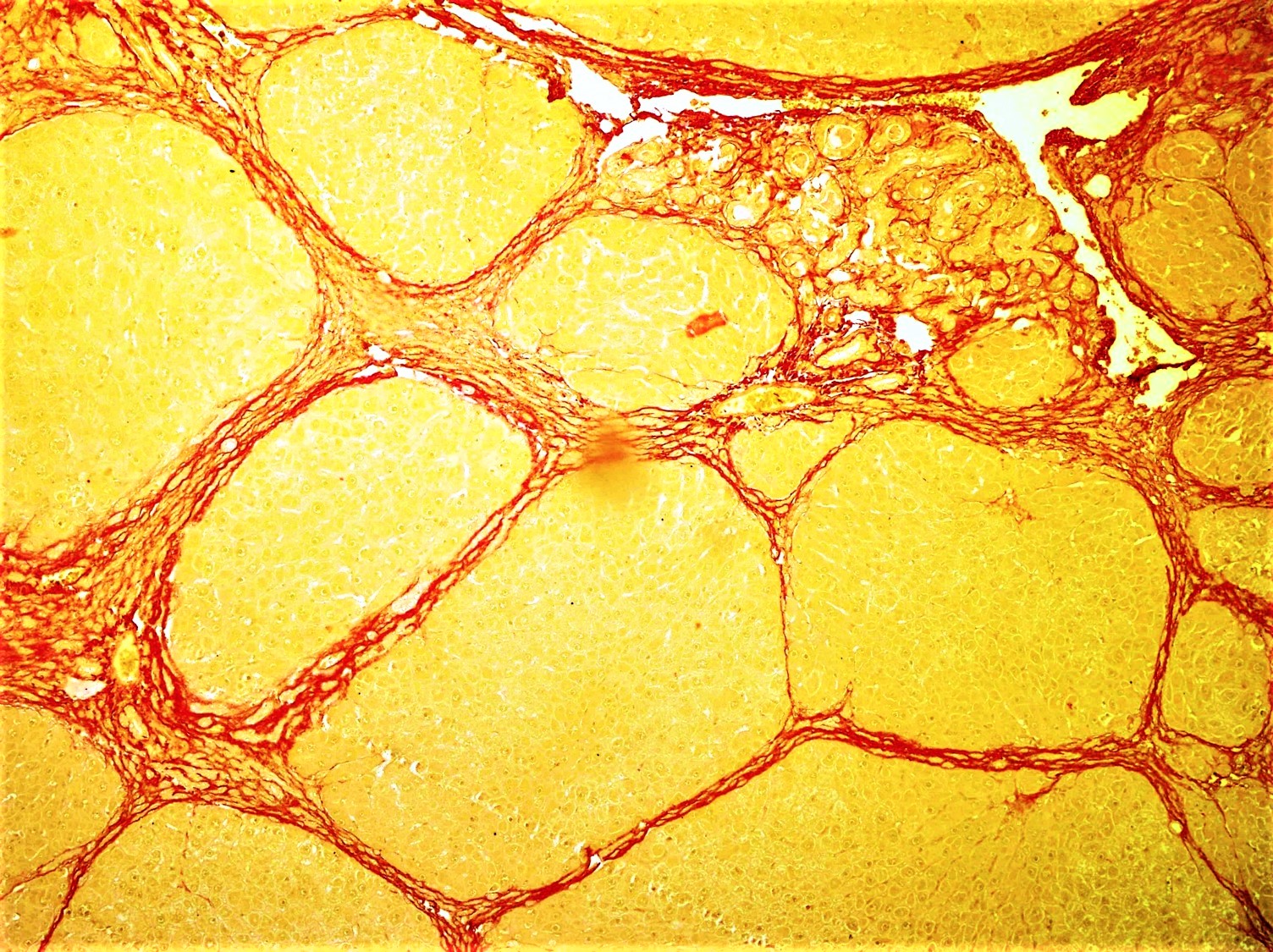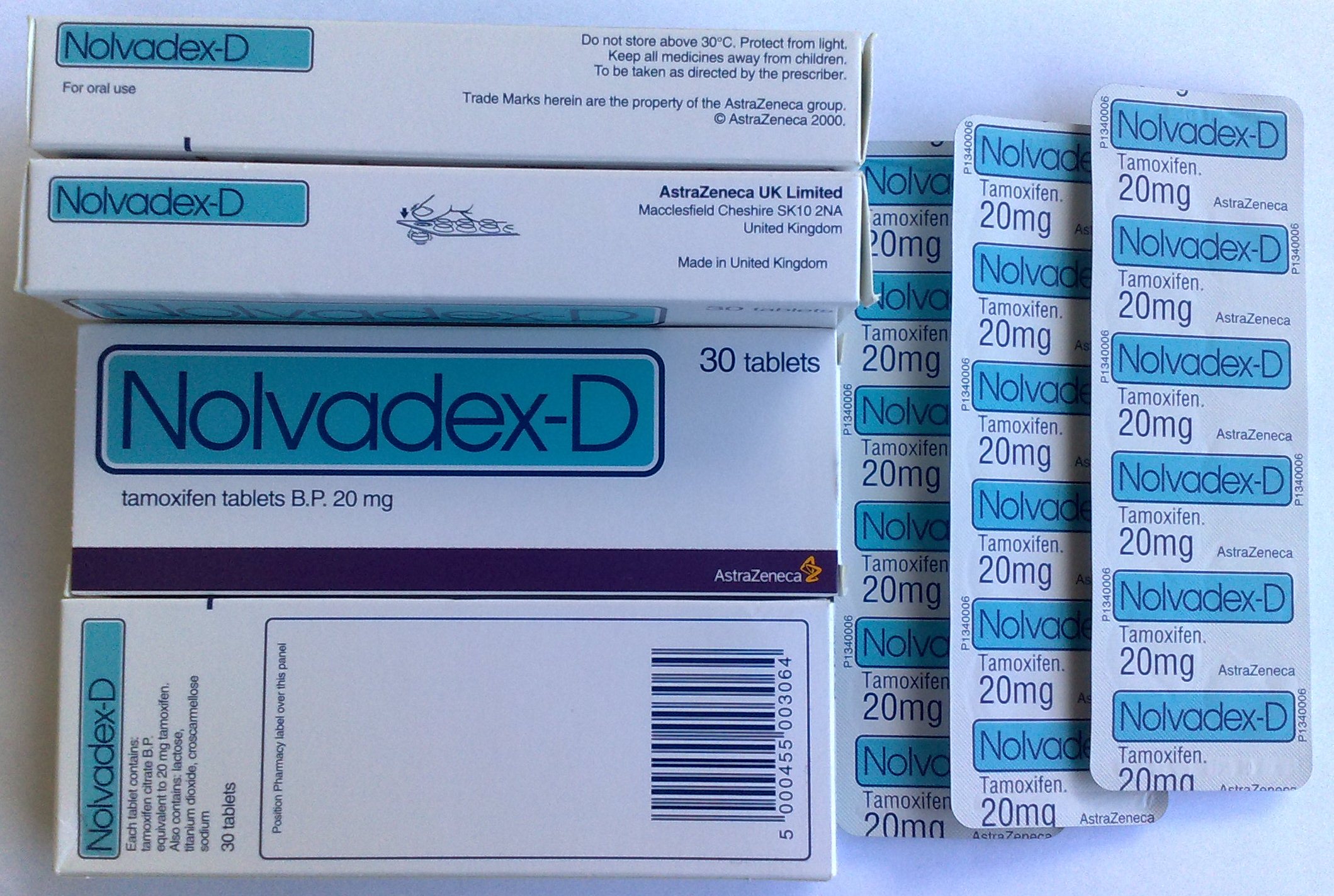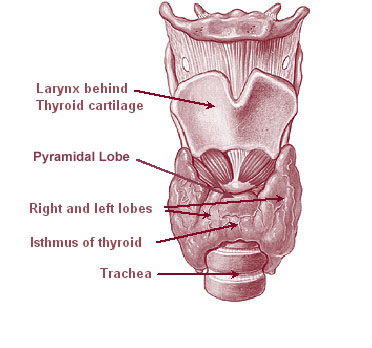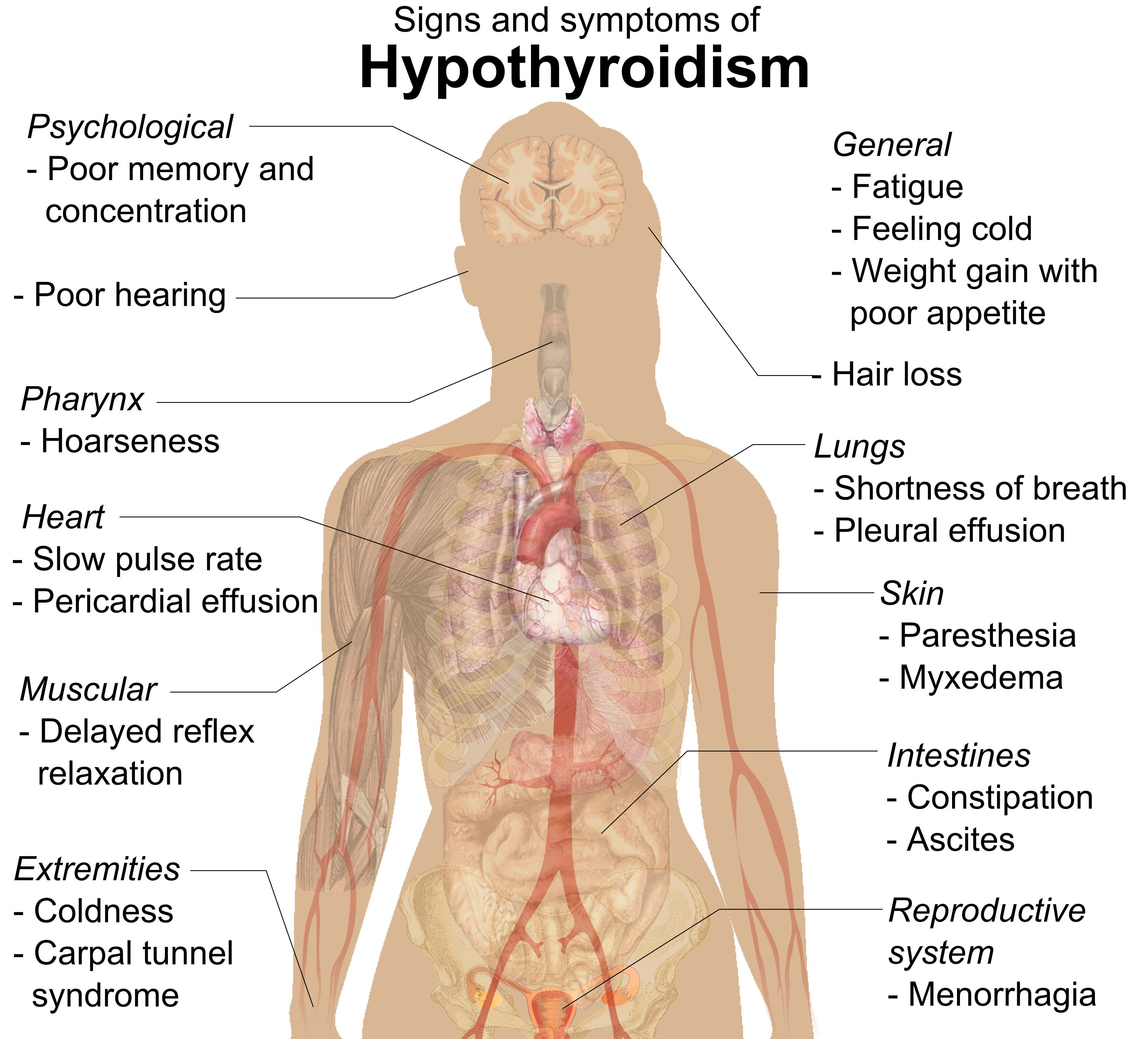|
Riedel's Thyroiditis
Riedel's thyroiditis (also known as invasive fibrous thyroiditis), is a chronic form of thyroiditis. It is now believed that Riedel's thyroiditis is one manifestation of a systemic disease that can affect many organ systems called IgG4-related disease. It is often a multi-organ disease affecting pancreas, liver, kidney, salivary and orbital tissues and retroperitoneal space. The hallmarks of the disease are fibrosis and infiltration by IgG4 secreting plasma cells. Signs and symptoms IgG4-related autoimmune diseases are characterized by excessive fibrosis. In case of Riedel's thyroiditis, fibrosis extends beyond the capsule and involves contiguous neck structures, clinically simulating thyroid carcinoma. There is a rapid thyroid enlargement. Compression of trachea, dysphagia are probable outcomes. Marked thyroid follicular cell atrophy confirms hypothyroidism. Signs of hypothyroidism include myxedema, lethargy, cold-intolerance, apathy, slowed intellectual functions, dysthymia or s ... [...More Info...] [...Related Items...] OR: [Wikipedia] [Google] [Baidu] |
Thyroiditis
Thyroiditis is the inflammation of the thyroid gland. The thyroid gland is located on the front of the neck below the laryngeal prominence, and makes hormones that control metabolism. Thyroiditis is a group of disorders that all cause thyroidal inflammation. Symptoms, diagnosis and treatment depend on the cause of thyroiditis. Forms of thyroiditis are Hashimoto's thyroiditis, postpartum thyroiditis, subacute (de Quervain's) thyroiditis, silent thyroiditis, drug-induced thyroiditis, radiation-induced thyroiditis and acute thyroiditis. Types Hashimoto's thyroiditis is an autoimmune disease where the body creates thyroid antibodies. It presents with hypothyroidism due to the destruction of thyroid cells. In Hashimoto's thyroiditis, the hypothyroidism is most often permanent, with symptoms are fatigue, weight gain, depression, dry skin, and constipation. Thyroid hormone replacement is the treatment of hypothyroidism. Silent thyroiditis or painless thyroiditis, also ... [...More Info...] [...Related Items...] OR: [Wikipedia] [Google] [Baidu] |
Retroperitoneal Space
The retroperitoneal space (retroperitoneum) is the spatium, anatomical space (sometimes a potential space) behind (''retro'') the peritoneum. It has no specific delineating anatomical structures. Organs are retroperitoneal if they have peritoneum on their anterior side only. Structures that are not suspended by mesentery in the abdominal cavity and that lie between the parietal peritoneum and abdominal wall are classified as retroperitoneal. This is different from organs that are not retroperitoneal, which have peritoneum on their posterior side and are suspended by mesentery in the abdominal cavity. The retroperitoneum can be further subdivided into the following: *Perirenal (or perinephric) space *Anterior pararenal (or paranephric) space *Posterior pararenal (or paranephric) space Retroperitoneal structures Structures that lie behind the peritoneum are termed "retroperitoneal". Organs that were once suspended within the abdominal cavity by mesentery but migrated posterior to ... [...More Info...] [...Related Items...] OR: [Wikipedia] [Google] [Baidu] |
Fibrosis
Fibrosis, also known as fibrotic scarring, is the development of fibrous connective tissue in response to an injury. Fibrosis can be a normal connective tissue deposition or excessive tissue deposition caused by a disease. Repeated injuries, chronic inflammation and repair are susceptible to fibrosis, where an accidental excessive accumulation of extracellular matrix components, such as the collagen, is produced by fibroblasts, leading to the formation of a permanent fibrotic scar. In response to injury, this is called scarring, and if fibrosis arises from a single cell line, this is called a fibroma. Physiologically, fibrosis acts to deposit connective tissue, which can interfere with or totally inhibit the normal architecture and function of the underlying organ or tissue. Fibrosis can be used to describe the pathological state of excess deposition of fibrous tissue, as well as the process of connective tissue deposition in healing. Defined by the pathological accumulation of ... [...More Info...] [...Related Items...] OR: [Wikipedia] [Google] [Baidu] |
Prednisolone
Prednisolone is a corticosteroid, a steroid hormone used to treat certain types of allergies, inflammation, inflammatory conditions, autoimmune disorders, and cancers, Electrolyte imbalance, electrolyte imbalances and skin conditions. Some of these conditions include adrenocortical insufficiency, hypercalcemia, high blood calcium, rheumatoid arthritis, dermatitis, eye inflammation, asthma, multiple sclerosis, and phimosis. It can be taken Oral administration, by mouth, intravenous, injected into a vein, used Topical medication, topically as a skin cream, or as Ophthalmic drug administration, eye drops. It differs from the similarly named prednisone in having a hydroxy group, hydroxyl at the 11th carbon instead of a ketone. Common side effects with short-term use include nausea, difficulty concentrating, insomnia, increased appetite, and fatigue. More severe side effects include psychiatric problems, which may occur in about 5% of people. Common side effects with long-term use ... [...More Info...] [...Related Items...] OR: [Wikipedia] [Google] [Baidu] |
Tamoxifen
Tamoxifen, sold under the brand name Nolvadex among others, is a selective estrogen receptor modulator used to prevent breast cancer in women and men. It is also being studied for other types of cancer. It has been used for Albright syndrome. Tamoxifen is typically taken daily by mouth for five years for breast cancer. Serious side effects include a small increased risk of uterine cancer, stroke, vision problems, and pulmonary embolism. Common side effects include irregular periods, weight loss, and hot flashes. It may cause harm to the baby if taken during pregnancy or breastfeeding. It is a selective estrogen-receptor modulator (SERM) and works by decreasing the growth of breast cancer cells. It is a member of the triphenylethylene group of compounds. Tamoxifen was initially made in 1962, by chemist Dora Richardson. It is on the World Health Organization's List of Essential Medicines. Tamoxifen is available as a generic medication. In 2020, it was the 317th mos ... [...More Info...] [...Related Items...] OR: [Wikipedia] [Google] [Baidu] |
Euthyroid
The thyroid, or thyroid gland, is an endocrine gland in vertebrates. In humans, it is a butterfly-shaped gland located in the neck below the Adam's apple. It consists of two connected lobe (anatomy), lobes. The lower two thirds of the lobes are connected by a thin band of Connective tissue, tissue called the isthmus (: isthmi). Microscopically, the functional unit of the thyroid gland is the spherical Thyroid follicular cell#Location, thyroid follicle, lined with thyroid follicular cell, follicular cells (thyrocytes), and occasional parafollicular cells that surround a follicular lumen, lumen containing colloid. The thyroid gland secretes three hormones: the two thyroid hormonestriiodothyronine, triiodothyronine (T3) and thyroid hormone, thyroxine (T4)and a peptide hormone, calcitonin. The thyroid hormones influence the basal metabolic rate, metabolic rate and protein biosynthesis, protein synthesis and growth and development in children. Calcitonin plays a role in Calcium m ... [...More Info...] [...Related Items...] OR: [Wikipedia] [Google] [Baidu] |
Hypothyroid
Hypothyroidism is an endocrine disease in which the thyroid gland does not produce enough thyroid hormones. It can cause a number of symptoms, such as poor ability to tolerate cold, extreme fatigue, muscle aches, constipation, slow heart rate, depression, and weight gain. Occasionally there may be swelling of the front part of the neck due to goiter. Untreated cases of hypothyroidism during pregnancy can lead to delays in growth and intellectual development in the baby or congenital iodine deficiency syndrome. Worldwide, too little iodine in the diet is the most common cause of hypothyroidism. Hashimoto's thyroiditis, an autoimmune disease where the body's immune system reacts to the thyroid gland, is the most common cause of hypothyroidism in countries with sufficient dietary iodine. Less common causes include previous treatment with radioactive iodine, injury to the hypothalamus or the anterior pituitary gland, certain medications, a lack of a functioning thyroid at ... [...More Info...] [...Related Items...] OR: [Wikipedia] [Google] [Baidu] |
Hyperthyroid
Hyperthyroidism is a endocrine disease in which the thyroid gland produces excessive amounts of thyroid hormones. Thyrotoxicosis is a condition that occurs due to elevated levels of thyroid hormones of any cause and therefore includes hyperthyroidism. Some, however, use the terms interchangeably. Signs and symptoms vary between people and may include irritability, muscle weakness, sleeping problems, a fast heartbeat, heat intolerance, diarrhea, enlargement of the thyroid, hand tremor, and weight loss. Symptoms are typically less severe in the elderly and during pregnancy. An uncommon but life-threatening complication is thyroid storm in which an event such as an infection results in worsening symptoms such as confusion and a high temperature; this often results in death. The opposite is hypothyroidism, when the thyroid gland does not make enough thyroid hormone. Graves' disease is the cause of about 50% to 80% of the cases of hyperthyroidism in the United States. Other caus ... [...More Info...] [...Related Items...] OR: [Wikipedia] [Google] [Baidu] |
Bernhard Moritz Carl Ludwig Riedel
Bernhard Moritz Carl Ludwig Riedel (18 September 1846 – 12 September 1916) was a German surgeon, who was a native of Teschentin, Grossherzogtum Mecklenburg (Grand Duchy of Mecklenburg). Biography He graduated from the University of Rostock in 1872, and for the next three years was prosector at Rostock under Friedrich Sigmund Merkel (1845–1919). In 1875, he became an assistant to Franz König (1832–1910) in Göttingen, where he was habilitated for surgery in 1877. In the ensuing years, he studied surgery with Bernhard von Langenbeck (1810–1887) and Heinrich Adolf von Bardeleben (1819–1895), later being appointed chief physician of the surgical department at the Städtisches Krankenhaus in Aachen (1881). In 1888, he became director of the surgical clinic at the University of Jena. Riedel was a pioneer in the surgical treatment of appendicitis and cholecystitis. In 1888, he performed the first choledochoduodenostomy (anastomosis of the common bile duct to the duodenum) ... [...More Info...] [...Related Items...] OR: [Wikipedia] [Google] [Baidu] |
